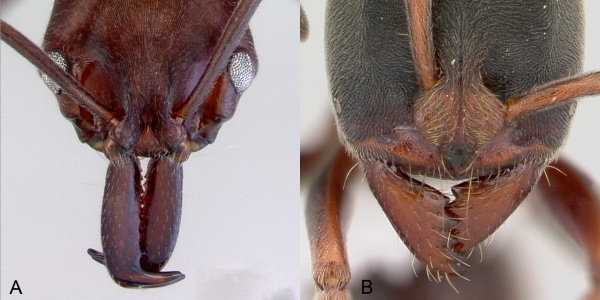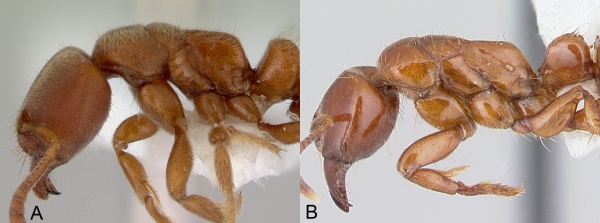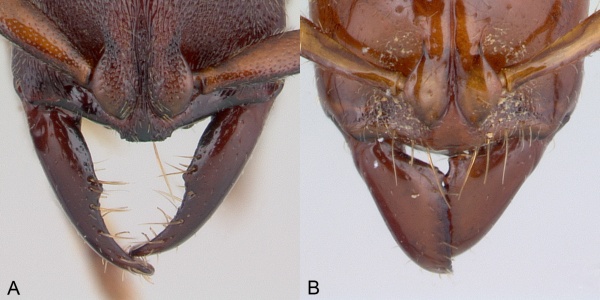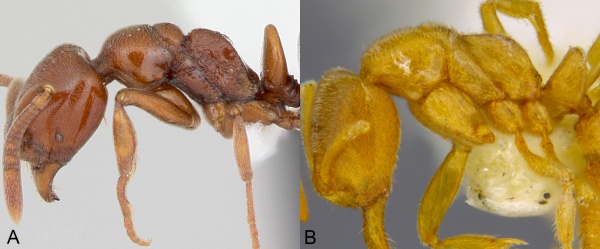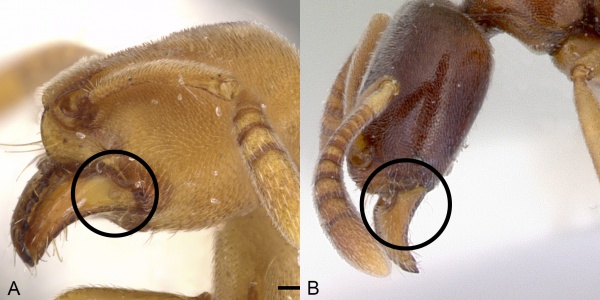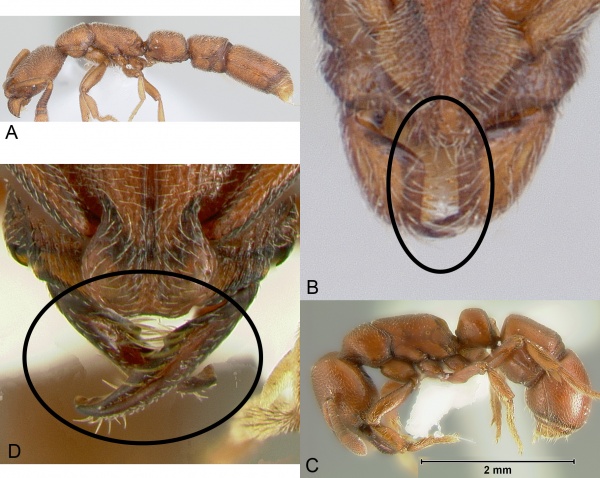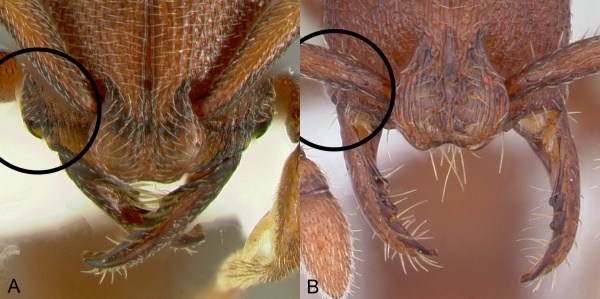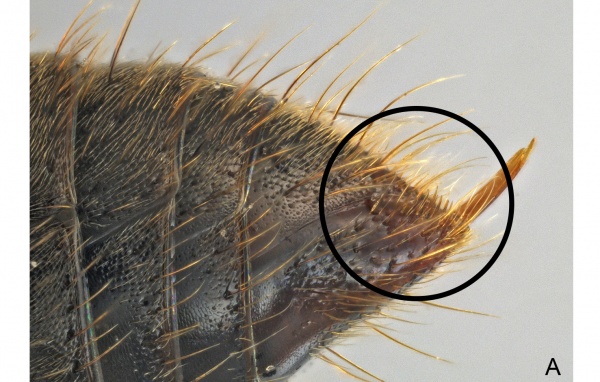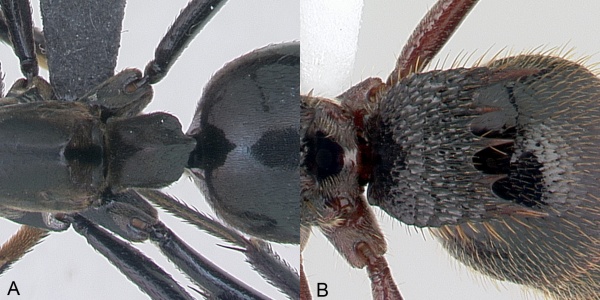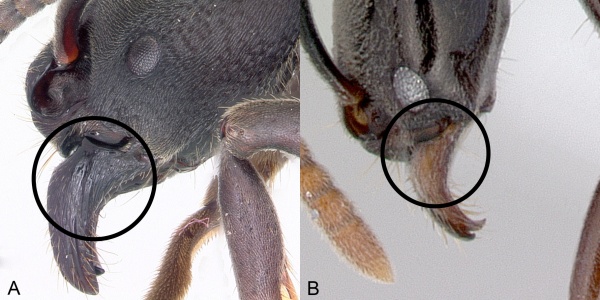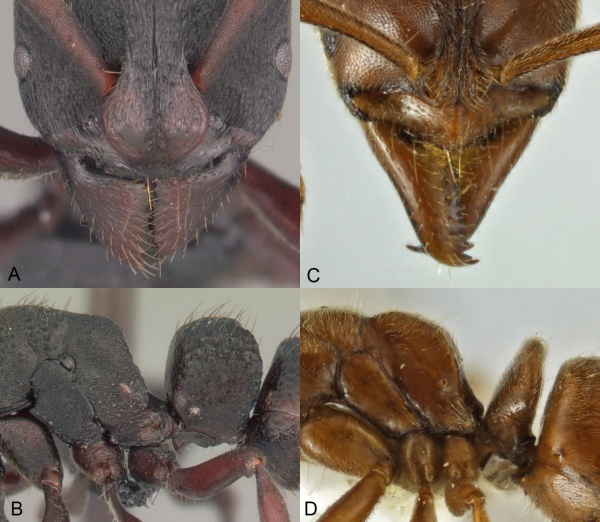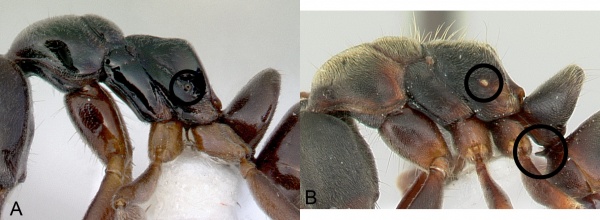Key to African and Malagasy Genera of Ponerinae
This worker key is based on: Schmidt, C.A. & Shattuck, S.O. 2014. The higher classification of the ant subfamily Ponerinae (Hymenoptera: Formicidae), with a review of ponerine ecology and behavior. Zootaxa. 3817, 1–242 (doi:10.11646/zootaxa.3817.1.1)
Including all of Africa, Madagascar, and the western islands of the Indian Ocean.
1
- Clypeus broadly inserted between frontal lobes, which appear flattened in frontal view, the antennal sockets widely separated (Fig. A). Metatibiae with two pectinate spurs. Tarsal claws armed with a single preapical tooth . . . . . 2
- Clypeus narrowly inserted between frontal lobes, the antennal sockets closely approximated (Fig. B). Metatibiae with one or two spurs. Tarsal claws usually unarmed, sometimes pectinate or armed with one or two preapical teeth . . . . . 3
2
return to couplet #1
- Preocular carinae absent. Petiole attached at approximately midheight of anterior face of first gastral segment (Fig. A) . . . . . Platythyrea
- Preocular carinae present. Petiole attached low on the anterior face of the first gastral segment (Fig. B) . . . . . Megaponera
3
return to couplet #1
- Mandibles long and linear, inserted medially on the front of the head. Eyes set on prominent ocular prominences (Fig. A) . . . . . 4
- Mandibles variously shaped, inserted at or near the anterolateral corners of the head. Eyes not set on prominent ocular prominences (Fig. B) . . . . . 5
4
return to couplet #3
- Nuchal carina continuously curved, the posterior surface of the head lacking a pair of dark apophyseal lines (Fig. A) . . . . . Anochetus
- Nuchal carina medially V-shaped, the posterior surface of the head with a pair of dark converging apophyseal lines (Fig. B) . . . . . Odontomachus
5
return to couplet #3
- Mesotibiae dorsally with abundant stout traction setae (Fig. A) … . . . . . 6
- Mesotibiae dorsally without abundant stout traction setae (a few stout setae sometimes present near tarsus but never extending along length of tibia) (Fig. B) . . . . . 9
6
return to couplet #5
- Mandibles triangular, with a basal pit. Metanotal groove distinct. Spiniform setae absent from meso- and metabasitarsi. Eyes present (but small) or absent in workers (Fig. A) . . . . . Cryptopone (in part)
- Mandibles variously shaped, but never with a basal pit. Metanotal groove usually obsolete. Spiniform setae present on meso- and metabasitarsi. Eyes absent in workers (Fig. B) . . . . . 7
7
return to couplet #6
- Mandibles linear. Anterior margin of clypeus with a blunt medial projection (Fig. A) . . . . . Promyopias
- Mandibles triangular to subtriangular. Anterior margin of clypeus without a blunt medial projection (Fig. B) . . . . . 8
8
return to couplet #7
- Anterior clypeal margin with a pair of small lateral projecting teeth. Frontal lobes closely approximated and overhanging the anterior clypeal margin. (Fig. A) Metapleural gland orifice located near the posteroventral corner of the metapleuron . . . . . Feroponera
- Anterior clypeal margin without a pair of projecting teeth. Frontal lobes not closely approximated and not overhanging the anterior clypeal margin. (Fig. B) Metapleural gland orifice located near the propodeal spiracle and opening laterally . . . . . Centromyrmex
9
return to couplet #5
- Ventral apex of the metatibia with a single spur, which is pectinate (Fig. A) . . . . . 10
- Ventral apex of the metatibia with one pectinate and one simple or barbulate spur (Fig. B) . . . . . 19
10
return to couplet #9
- Propodeal spiracle slit-shaped (Fig. A) . . . . . 11
- Propodeal spiracle round or ovoid (Fig. B) . . . . . 12
11
return to couplet #10
- Eyes present. Metanotal groove strongly impressed and “V”-shaped (Fig. A) . . . . . Asphinctopone
- Eyes absent (or present only as a pigmented spot). Metanotal groove angular, the propodeum depressed below the mesonotum (Fig. B) . . . . . Fisheropone
12
return to couplet #10
- Petiole scale-like and thin (Fig. A). Frontal lobes small (Fig. B) . . . . . 13
- Petiole surmounted by a thick node (Fig. C). Frontal lobes large (Fig. D) . . . . . 15
13
return to couplet #12
- Mandibles with a basal pit or fovea (Fig. A) . . . . . Cryptopone (in part)
- Mandibles without a distinct basal pit or fovea (Fig. B) . . . . . 14
14
return to couplet #13
- Subpetiolar process with an anterior fenestra and paired posteroventral teeth (Fig. A) . . . . . Ponera
- Subpetiolar process without both an anterior fenestra and paired posteroventral teeth (Fig. B) . . . . . Hypoponera
15
return to couplet #12
- Mandible with a long curved attenuated apical tooth (Fig. A). Labrum projecting beyond the anterior clypeal margin . . . . . Psalidomyrmex
- Mandible without a long attenuated apical tooth (Fig. B). Labrum not projecting beyond the anterior clypeal margin . . . . . 16
16
return to couplet #15
- Body extremely elongate (Fig. A). Mandibles with a row of peg-like setae on their inner margins (Fig. B). Posterior propodeal margins not expanded to form lamellae. Metafemur without a dorsal groove . . . . . Dolioponera
- Body not extremely elongate (Fig. C). Mandibles without a row of peg-like setae on their inner margins (Fig. D). Posterior propodeal margins expanded posteriorly to form lamellae. Metafemur with a dorsal groove . . . . . 17
17
return to couplet #16
- A4 tergite strongly vaulted, the gaster downcurved posteriorly. Posteroventral corners of head with a projecting flange (Fig. A) . . . . . Loboponera
- A4 tergite not strongly vaulted. Posteroventral corners of head without a projecting flange (Fig. B) . . . . . 18
18
return to couplet #17
- Mandible thin and curved, with both a dorsal and a lateral longitudinal groove (Fig. A). Clypeus with a lateral excavation at the base of each mandible (Fig. A). Eyes generally present, varying from moderately large to very small, rarely absent . . . . . Plectroctena
- Mandible triangular, with only a lateral longitudinal groove (Fig. B). Clypeus without lateral excavations (Fig. B). Eyes absent . . . . . Boloponera
19
return to couplet #9
- Tarsal claws usually pectinate (Fig. A), sometimes armed with only one to three preapical teeth. Gaster generally with a strong girdling constriction (sometimes constriction essentially absent). Frontal lobes very small. Body slender . . . . . Leptogenys
- Tarsal claws unarmed (Fig. B) or at most armed with one preapical tooth, in which case the gaster lacks a strong girdling constriction, the frontal lobes are of moderate size, and the body is not especially slender . . . . . 20
20
return to couplet #19
- Hypopygium with a row of stout setae along each side of the sting (sometimes partially hidden by surrounding thinner hairs) (Fig. A) . . . . . 21
- Hypopygium without a row of stout setae along each side of the sting . . . . . 22
21
return to couplet #20
- Eyes very large, located at or posterior to the head midline (Fig. A). Clypeus without a blunt medial anterior projection (Fig. A). Propodeal spiracle slit-shaped . . . . . Ophthalmopone
- Eyes of moderate size, located anterior to the head midline (Fig. B). Clypeus with a blunt medial anterior projection (Fig. B). Propodeal spiracle oval to circular . . . . . Paltothyreus
22
return to couplet #20
- Tarsal claws armed with a single preapical tooth (Fig. A) . . . . . Hagensia
- Tarsal claws unarmed (Fig. B) . . . . . 23
23
return to couplet #22
- Propodeum with a pair of spines or teeth on the posterodorsal margin (near the angle) (Fig. A) . . . . . 24
- Propodeum without a pair of spines or teeth on the posterodorsal margin (near the angle) although teeth sometimes present along the posterior propodeal face (Fig. B) . . . . . 25
24
return to couplet #23
- Petiole tall and fin-like, with sharp lateral margins and a longitudinal dorsal carina (Fig. A) . . . . . Streblognathus
- Petiole with five sharp posteriorly-projecting teeth on the posterodorsal margin (Fig. B) . . . . . Phrynoponera
25
return to couplet #23
- Mandible smooth or with an elongate suture basally, but never with a pit or short groove (Fig. A) . . . . . 26
- Mandible with a small basal pit or short groove, but never with an elongate basal suture (Fig. B) . . . . . 28
26
return to couplet #25
- Compound eyes small (with 2-4 facets) or absent. Subpetiolar process with an anterior fenestra and/or a pair of teeth (Fig. A) . . . . . Parvaponera
- Compound eyes present and larger, with numerous facets. Subpetiolar process simpler, without a fenestra or teeth (but sometimes various small projections) (Fig. B) . . . . . 27
27
return to couplet #26
- Mandible relatively short and often with an elongate basal suture (Fig. A). Metanotal groove absent. Propodeal spiracle elongate. Petiole surmounted by a thick node (Fig. B) . . . . . Bothroponera
- Mandible generally elongate and never with a basal suture (Fig. C). Metanotal groove impressed (weakly to strongly). Propodeal spiracle round or elongate. Petiolar node generally scale-like and thin (Fig. D), sometimes broader but never thick . . . . . Mesoponera
28
return to couplet #27
- Metanotal groove distinct. Propodeal spiracle round or ovoid. Prora absent from anterior margin of first gastral sternite (Fig. A) . . . . . Brachyponera
- Metanotal groove obsolete or distinct. Propodeal spiracle slit-shaped. Prora present on anterior margin of first gastral sternite (Fig. B) . . . . . Euponera


